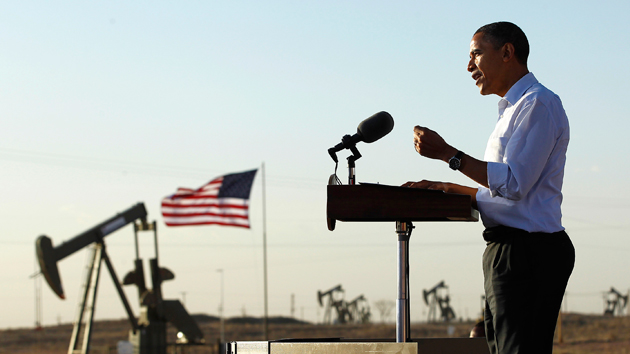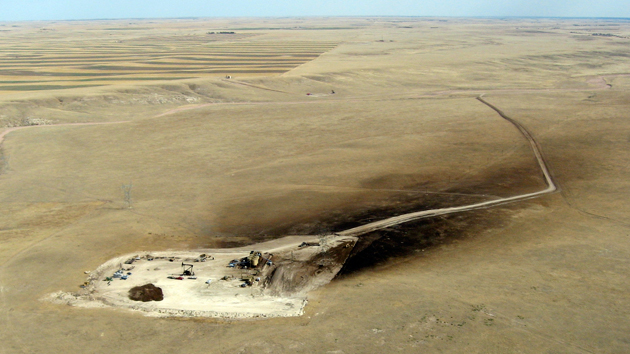
President Obama speaks at an oil and gas field in New Mexico, March 2012. AP Images/Ross D. Franklin
This story first appeared on the TomDispatch website.
Considering all the talk about global warming, peak oil, carbon divestment, and renewable energy, you’d think that oil consumption in the United States would be on a downward path. By now, we should certainly be witnessing real progress toward a post-petroleum economy. As it happens, the opposite is occurring. US oil consumption is on an upward trajectory, climbing by 400,000 barrels per day in 2013 alone—and, if current trends persist, it should rise again both this year and next.
In other words, oil is back. Big time. Signs of its resurgence abound. Despite what you may think, Americans, on average, are driving more miles every day, not fewer, filling ever more fuel tanks with ever more gasoline, and evidently feeling ever less bad about it. The stigma of buying new gas-guzzling SUVs, for instance, seems to have vanished; according to CNN Money, nearly one out of three vehicles sold today is an SUV. As a result of all this, America’s demand for oil grew more than China’s in 2013, the first time that’s happened since 1999.
Accompanying all this is a little noticed but crucial shift in White House rhetoric. While President Obama once spoke of the necessity of eliminating our reliance on petroleum as a major source of energy, he now brags about rising US oil output and touts his efforts to further boost production.
Just five years ago, few would have foreseen such a dramatic oil rebound. Many energy experts were then predicting an imminent “peak” in global oil production, followed by an irreversible decline in output. With supplies constantly shrinking, it was said, oil prices would skyrocket and consumers would turn to hybrid vehicles, electric cars, biofuels, and various transportation alternatives. New government policies would be devised to facilitate this shift, providing tax breaks and other incentives for making the switch to renewables.
At that time, a growing concern over climate change and the prospect of further warming due to increased emissions of carbon dioxide from the burning of fossil fuels seemed to dim the long-term prospects for petroleum. After all, oil combustion is this country’s single largest source of carbon emissions. This, in turn, clearly meant that any significant attempt to reduce emissions—whether through a carbon tax, a carbon cap-and-trade program, or other such measures—would naturally have to incorporate significant impediments to oil use. President Obama entered the White House promising to enact such a measure, and the House of Representatives passed a modified cap-and-trade bill in 2009. (It failed in the Senate and so never became law.)
The 2008 financial crisis and global economic meltdown only put oil’s future in further doubt. Suddenly cash-conscious Americans began trading in their gas-guzzlers for smaller, more fuel-efficient cars, with the Obama administration adding its encouragement. When agreeing to the bailout of General Motors, for instance, the White House insisted that the reorganized company focus on the production of such vehicles. In a similar spirit, the administration’s $787 billion stimulus package favored investment in electric cars, biofuels, high-speed rail, and other petroleum alternatives.
The president’s comments at the time clearly reflected a belief that oil was an “old” form of energy facing inevitable decline. “The United States of America cannot afford to bet our long-term prosperity, our long-term security on a resource that will eventually run out, and even before it runs out will get more expensive to extract from the ground,” he declared in 2011. “We can’t afford it when the costs to our economy, our country, and our planet are so high.” Not only did the country need to lessen its dangerous reliance on imported oil, he insisted, but on oil altogether. “The only way for America’s energy supply to be truly secure is by permanently reducing our dependence on oil.”
Obama’s Turnaround on Oil
That was then and this is now, and Obama ain’t talking that way no more. Instead, he regularly boasts of America’s soaring oil output and points to all he’s done and is still doing to further increase domestic production. Thanks to the sort of heightened investment in domestic output his administration has sponsored, he told a cheering Congress in January, “more oil [was] produced at home than we buy from the rest of the world—the first time that’s happened in nearly twenty years.” Although still offering his usual bow to the dangers of climate change, Obama did not hesitate to promise to facilitate further gains in domestic output.
 In accord with his wishes, the Bureau of Ocean Energy Management (BOEM) announced on July 18th that it would reopen a large portion of the waters off the Eastern seaboard, an area stretching all the way from Florida to Delaware, to new oil and natural gas exploration. Under the BOEM plan, energy companies will be allowed to employ advanced seismic technology to locate promising reserves beneath the seabed in preparation for a round of offshore licensing scheduled for 2018. At that point, the companies can bid for and acquire actual drilling leases. Environmental organizations have condemned the plan, claiming the seismic tests often involve the use of sonic blasts that could prove harmful to endangered sea animals, including whales. The truth is, however, that those seismic tests, by opening future fossil fuel deposits to development and exploitation, are likely, in the long run, to hurt human beings at least as much.
In accord with his wishes, the Bureau of Ocean Energy Management (BOEM) announced on July 18th that it would reopen a large portion of the waters off the Eastern seaboard, an area stretching all the way from Florida to Delaware, to new oil and natural gas exploration. Under the BOEM plan, energy companies will be allowed to employ advanced seismic technology to locate promising reserves beneath the seabed in preparation for a round of offshore licensing scheduled for 2018. At that point, the companies can bid for and acquire actual drilling leases. Environmental organizations have condemned the plan, claiming the seismic tests often involve the use of sonic blasts that could prove harmful to endangered sea animals, including whales. The truth is, however, that those seismic tests, by opening future fossil fuel deposits to development and exploitation, are likely, in the long run, to hurt human beings at least as much.
Here are some of the other measures recently taken by the administration to boost domestic oil production, according to a recent White House factsheet:
* An increase in the sales of leases for oil and gas drilling on federal lands. In 2013, the Bureau of Land Management held 30 such sales—the most in a decade—offering 5.7 million acres for lease by industry.
* An increase in the speed with which permits are being issued for actual drilling on federal lands. What’s called “processing time” has, the White House boasts, been cut from 228 days in 2012 to 194 days in 2013.
* The opening up of an additional 59 million acres for oil and gas drilling in the Gulf of Mexico, the site of a disastrous BP oil spill in April 2010.
In other words, global warming be damned!
In a turnaround that has gotten next to no attention and remarkably little criticism, President Obama is now making a legacy record for himself that will put the “permanent reduction of our dependence on oil” in its grave. His administration is instead on a drill-baby-drill course to increase production in every way imaginable on US territory, including offshore areas that were long closed to drilling due to environmental concerns.
What explains this dramatic turnaround?
The Rekindled Allure of Oil
The most significant factor behind the renewed popularity of oil has been a revolution in drilling technology. In particular, this involves the use of horizontal drilling and hydraulic fracturing (“fracking”) to extract oil and natural gas from previously inaccessible shale formations. These techniques include the use of drills that can turn sideways after penetrating thin underground shale layers, along with high-pressure water cannons to fracture the surrounding rock and liberate pockets of oil and gas. Until the introduction of these techniques, the hydrocarbons trapped in the shale were prohibitively expensive to produce and so ignored both by industry and the many experts predicting that “peak oil” was in sight.
Most domestic shale “plays” (as they are called in the industry) contain both oil and natural gas. They were first exploited for their gas content because of the greater ease in extracting commercial volumes of that fossil fuel. But when the price of gas collapsed—in part because of a glut of shale gas—many drillers found that they could make more money by redeploying their rigs in oil-rich shales like the Bakken formation in North Dakota and Eagle Ford in West Texas. The result has been a sudden torrent of domestic crude that has brought gasoline prices down (with a resulting increase in gasoline consumption) and created boom-like conditions in several parts of the country.
Prior to the utilization of horizontal drilling and fracking technology, US crude production was indeed facing long-term decline. According to the Energy Information Administration (EIA) of the Department of Energy, domestic crude output fell from a peak of 9.6 million barrels per day in 1970 to a low of 5 million barrels in 2008. With the introduction of fracking, however, the numbers started to soar. Total US crude output jumped from 5.7 million barrels per day in 2011 to 7.5 million in 2013. Output in 2014 is projected to be 8.5 million barrels per day, which would represent a remarkable increase of 2.8 million barrels per day in just three years.
The increase is, by the way, the largest posted by any of the world’s oil producers from 2011-2013 and has generated multiple economic benefits for the country, along with significant environmental consequences. For one thing, it has kept gas prices relatively low. They are now averaging about $3.50 per gallon—a lot more than Americans were paying in the 1990s, but a lot less than most experts assumed would be the case in a post-peak-oil economy. This has, of course, spurred both those SUV sales and an increase in recreational driving. (“We were able to take a day-cation because of the lower gas prices,” said Beth Hughes, of a four-hour roundtrip drive with her husband to San Antonio, to visit the Alamo and do some shopping.)
The increased availability of relatively affordable oil has also spurred investment in ancillary industries like petrochemicals and plastics. Petroleum is the basic raw material, or “feedstock,” for a wide variety of subsidiary materials, including ethylene, propylene, and benzene, which in turn are used to make polyesters, plastics, and numerous consumer products. Many chemical firms have built new facilities to convert shale oil and shale gas into these commodities, a spur both to new jobs and greater tax revenues. In addition, with crude oil selling at around $100 per barrel, those extra 2.8 million barrels produced daily will add about $100 billion to the US economy in 2014, a substantial contribution to an otherwise tepid recovery.
Of course, the environmental downside to all this, already significant, could be staggering for the future. The use of hydro-fracking to release all that shale oil has resulted in the diversion of vast quantities of water to energy production, in the process regularly posing a threat to local water supplies. In some drought-affected areas, oil drilling is now competing with farming for access to ever-diminishing supplies of fresh water. The growing use of railroads to carry shale oil—an especially volatile hydrocarbon substance—has also led to several lethal explosions, triggered by accidents involving old and inadequately reinforced tank cars.
Of course, the greatest environmental fallout from the domestic oil boom will be a continuing deluge of carbon dioxide emissions into the atmosphere, further bolstering the greenhouse effect and ensuring higher world temperatures for years to come. While emissions from domestic coal use are likely to decline in the years ahead, in part due to new rules being formulated by the Environmental Protection Agency, the expected rise in emissions from oil and natural gas use will wipe out these gains, and so total US emissions are expected to be higher in 2040 than they are today, according to the EIA. As a result, we can expect little progress in international efforts to slow the advance of climate change and a steady increase in the frequency and intensity of storms, floods, fires, droughts, and heat waves.
As seen from Washington, however, the domestic oil rebound is largely a feel-good story and an essential part of an otherwise anemic economic recovery. Putting people back to work, Obama declared in May, “starts with helping businesses create more good jobs. One of the biggest factors in bringing jobs back to America has been our commitment to American energy over the last five years. When I took office, we set out to break our dependence on foreign oil. Today, America is closer to energy independence than we have been in decades.”
“A Stronger Hand”
For the president and many other politicians, increased oil output, however important as a source of economic vitality and job creation, is far more than that. It is also a source of power and prestige, guaranteed to give the United States greater leverage in international affairs.
As Tom Donilon, then the president’s senior adviser on national security, explained in April 2013, “America’s new energy posture allows us to engage from a position of greater strength. Increasing US energy supplies act as a cushion that helps reduce our vulnerability to global supply disruptions and price shocks. It also affords us a stronger hand in pursuing and implementing our international security goals.”
One area where American energy prowess has given us “a stronger hand,” he suggested, was in negotiations with Tehran over the Iranian nuclear program. Because the US is importing less oil, there is a larger pool of foreign oil on which our allies can draw for their needs, which has made it easier to impose tough sanctions on Iran’s petroleum exports—and so wring concessions from Iran’s leadership circle.
Another area where many Washington pundits and politicians believe increased oil and gas production has strengthened the president’s hand lies in the administration’s efforts to impose multilateral sanctions on Russia’s energy companies as a punishment for the Kremlin’s covert backing of anti-government rebels in eastern Ukraine. Although still dependent on Russia for a large share of their energy intake, America’s European allies are feeling somewhat less deferential to Moscow because of the growth in global supplies.
In other words, the striking spurt in domestic oil production has added a patriotic dimension to its already powerful allure.
Collective Schizophrenia
As polls show, most Americans acknowledge the reality of climate change and support efforts to reduce carbon emissions in order avert future climate-induced disasters. California and other states have even taken significant steps to reduce energy-related emissions and the Obama administration has, among other things, announced plans to improve the fuel efficiency of American cars and trucks.
In addition, the president and many in his administration clearly grasp the dangers of climate change—the increasing heat, drought, fiercer storms, rising sea levels, and other perils that, without serious curbs on the combustion of fossil fuels, will make the present look like a utopian moment in human history. Nevertheless, the numbers—from production to consumption—are anything but promising. According to the latest EIA projections, US carbon dioxide emissions from petroleum use will increase by eight million metric tons between 2013 and 2015; such emissions are then expected to level off, at about 2.2 billion tons per year, despite substantial increases in average vehicle fuel efficiency.
With emissions from natural gas expected to rise—the inevitable result of the shale gas boom—and coal emissions experiencing only a modest decline (some of which is offset by rising US exports of coal to be burned elsewhere), total domestic carbon emissions from energy use in 2040 are still predicted to be a devastating 6% higher than they are today. Can there be any question at this point of how this will help ensure the sorts of predicted global temperature increases, with all the ensuing side effects, that every expert knows will be devastating to the planet?
At a national level, such a situation—knowing one thing and doing something else—can only be described as some form of mass delusion or a collective version of schizophrenia. In one part of our collective brain, we are aware that petroleum use must decline sharply to prevent the sorts of global catastrophes that we are only used to seeing in science fiction movies; in another, we retain our affection for driving and gasoline use without giving much thought to the consequences. We have a global warming president presiding over a massive expansion of fossil fuel production. Think of this as a form of collective mental compartmentalization that should frighten us all—and yet from the president on down, it’s remarkable how few seem disturbed by it.
Obviously, this is an unsustainable condition. Eventually, excessive petroleum use will produce such frequent and severe climate effects that no president or energy executive would dare boast of increased petroleum output and none of us would even dream of filling up the gas tank to take a “day-cation” at a distant tourist site. Until we identify and begin treating this state of national schizophrenia, however, we will ensure that a time of mutual pain and hardship is ever more likely.
Michael T. Klare, a TomDispatch regular, is a professor of peace and world security studies at Hampshire College and the author, most recently, of The Race for What’s Left. A documentary movie version of his book Blood and Oil is available from the Media Education Foundation. To stay on top of important articles like these, sign up to receive the latest updates from TomDispatch.com here.

















